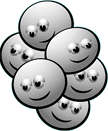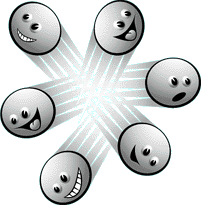|

What if I don't have any baby food jars?
If you don't have any baby food jars and you don't
have a baby who will empty some jars for you, we suggest that you buy a
jar of strained peaches or applesauce baby food. You can empty the jars
over vanilla ice cream for a tasty dessert or mix them in a blender with
milk and ice to make a smoothie. If you don't want to buy baby food, we
have also done this experiment using two identical small, clear, drinking
glasses. You just have to make sure that the mouths of the glasses match
up perfectly, without a leak.
 Why
does the water mix so quickly when the glass of hot water is on the bottom?
Why
does the water mix so quickly when the glass of hot water is on the bottom?
If you've already made a
Salt Volcano
or a
Glitter Globe
, you probably know
that some liquids float on top of other liquids. Oil floats on water. Alcohol
floats on oil. That's because these liquids have different densities. Whenever
you put together two liquids that don't mix, the liquid that is less dense
will float on top of the denser liquid. A drop of oil weighs less than a
drop of water the same size. The oil is less dense than the water, so it
rises to the top.
 When you
heat up water, the water molecules start moving around faster and faster.
They bounce off each other and move farther apart. Because there's more
space between the molecules, a volume of hot water has fewer molecules in
it and weighs a little bit less than the same volume of cold water. So hot
water is less dense than cold water. When you put the two together with
the hot water on the bottom, the hot water rises to the top, mixing with
the cold water along the way and creating purple water.
When you
heat up water, the water molecules start moving around faster and faster.
They bounce off each other and move farther apart. Because there's more
space between the molecules, a volume of hot water has fewer molecules in
it and weighs a little bit less than the same volume of cold water. So hot
water is less dense than cold water. When you put the two together with
the hot water on the bottom, the hot water rises to the top, mixing with
the cold water along the way and creating purple water.
Why doesn't the water mix when the hot water is on top?
When the cold water is on the bottom, the hot water doesn't have to rise--it's
already on top. The cold blue water stays on the bottom and the hot red
water stays on top.
How can I experiment further?
What do you think would happen if you tried this experiment with a jar of
salt water on top and a jar of water without salt on the bottom? Try it
and see. Use food coloring to color the salt water a different color than
the plain water so that you can see what happens.
|